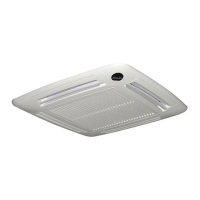10
IFCLTY 1112 - 4528511_04
Minimum average water temperature
If the fan coil is working in continuous
cooling mode in an environment where
the relative humidity is high, condensate
might form on the air delivery and
on the outside of the device. This
condensate might be deposited on any
objects underneath and on the floor.
To avoid condensate on the external
structure of the device while the fan is
functioning, the average temperature of
the water must not be lower than the
limits shown in the table below, that
depend on the thermo-hygrometric con-
ditions of the air in the room.
These limits refer to unit operating with
fan at minimum speed.
OPERATING LIMITS
Performance values refer to the following conditions:
- at the maximum motor speed;
- the total input power is determined by adding the input power
for the unit to the input power for the accessories connected
and declared in the corresponding manuals.
Water temperature
In order to prevent air stratification in the
room, and therefore to achieve improved
mixing, it is advisable not to supply the fan
coil with water at a temperature over 65°C.
The use of water at high temperatures
could cause squeaking due to the different
thermal expansions of the elements
(plastic and metal), this does not however
cause damage to the unit if the maximum
operating temperature is not exceeded.
SELECTION CRITERIA
The main technical data of the FCL
range are summarised in the tables.
The tables show the sensible and total
refrigerating yield at maximum speed,
in relation to the temperature of the
inlet water, its temperature change
and the air temperature with dry bulb
and wet bulb (for the sensitive output
and the total output respectively).
The performance levels at average
and minimum speed are obtained by
multiplying the tabular values by the
relative correction factors.
The water side pressure drops are
shown in the charts.
The correction factors when the unit
operates with glycol water for cooling
and heating function modes are
shown in the graphs in percentages of
glycol of 10%, 20% and 35%.
The heating capacity in relation to
the water flow rate, and to the
temperature difference between the
incoming water and the incoming
air, is shown in a chart. It refers to
maximum speed; the performance
levels at average and minimum
speed are obtained by multiplying
the values obtained from the graph
(at maximum speed) by the relative
correction factors.
The sound pressure and power levels of
the fan coils at the various speeds are
shown in the tables.
There is a wide range of accessories
for the FCL fan coils, but in certain
cases some of them cannot be used
simultaneously: check the accessories
are compatible with the fan coil
chosen. The manual contains a
description of each accessory, plus a
drawing and its compatibility.
The installation information is included
in the manuals supplied together with
each fan coil or its accessory. This
manual is limited to provide general
information in order to obtain a
correct installation; it also contains
drawings with fan coil dimensions
and the wiring diagrams with the
connections to control panels.
FCL 32 34 36 38 42 44 62 64 72 82 84 102 104 122 124
Maximum water inlet temperature [°C] 80
Maximum operating pressure [bar] 8
Minimum water flow rate (heating) [l/h]
100 50 100 50 100 50 150 50 150 250 150 350 150 350 150
Maximum water flow rate (heating) [l/h] 750 400 750 400 750 400 1050 400 1050 1750 1200 2450 1200 2450 1200
Minimum water flow rate (cooling) [l/h] 100 100 100 100 100 100 150 150 150 250 250 350 250 350 250
Maximum water flow rate (cooling) [l/h] 750 750 750 750 750 750 1050 1050 1050 1750 1750 2450 1750 2450 1750
Room temperature limits (Ta) [C°] 0 < Ta < 40
Relative humidity limits in the room R.H. U.R. < 85%
Power supply 230V ( ±10% ) ~ 50Hz
AVERAGE MINIMUM TEMPERATURE OF THE WATER [°C]
Dry bulb temperature of the room temperature [°C]
21 23 25 27 29 31
Wet bulb temperature
of the room air [°C]
15 333333
17 333333
19 333333
21 654333
23 -87655

